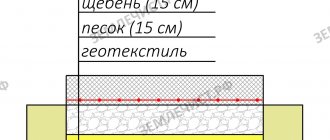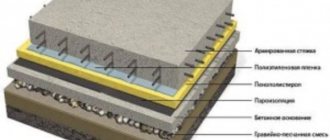What to use instead of paving slabs - an interesting replacement option
The courtyards of private houses will become the most favorite vacation spot for the whole family, an area for children to play and to park personal vehicles. The principles of landscape design and decorative planting will also not be in last place. For this reason, there are currently many requirements for yard coverings.
Using and following zoning rules makes it possible to combine different coverings of the local area, but they are all required
Design
The concrete surface is gray and nondescript. Despite all the desire, there is no place for a designer to show his talents. However, monochromatic solutions have their advantages: they can contrast with other components of the exterior.
Paving slabs in the yard are another matter. A large number of shapes (from banal rectangles to “coils”), sizes (from 4 to 50 pieces per square meter), colors (gray, red, yellow, brown). It is logical that with such variety there is much more room for imagination. In addition, there are many laying schemes even for single-color tiles of the same shape: “wave”, “brick”, “clover”.
Rubber tiles on the street
Such cladding has many advantages, and its use is expanding. One of the main factors is that during the cold season you will not have to treat with special compounds or reagents. A number of tile qualities that are worth listing:
- Simplicity in production technology.
- Long period of operation, which is guaranteed for 10 years.
- Easy to install and maintain.
- Resistant to aggressive chemicals and moisture.
- Resistance against temporary influence of alkali and acid.
- High strength under temperature changes, properties are not lost from +600C to -450C.
- Rubber is a waterproof material. Repels moisture that may get onto the base. This type of coating is often used as additional drainage.
- Withstands mechanical loads, which helps prevent chipping.
- It has elasticity, making it resistant to strong impacts.
- Economical coverage, there will be no need to purchase extra square meters.
- Wide selection of color shades and tile shapes.
Certain types of such tiles have an orthopedic effect. Used for sports complexes and playgrounds.
Practicality
In summer, the concrete surface can be swept and washed with a hose. Please note that you will have to do this often: concrete is very dusty. Ice and snow are removed from the surface with ordinary shovels and crowbars.
In the warm season, private yards with paving slabs are washed with soapy water: it helps to deal with tire marks, gasoline stains, and traces of soot. To deal with paint drips, you will need a special solvent. In winter, it is advisable to use a shovel made of wood or plastic. A shovel or crowbar will ruin the fragile coating.
Installation of paving stones
Having chosen such a tile, you should rationally purchase a coating of the desired shape, color and thickness. The first two parameters depend on the style in which the sidewalks, platforms or building interior are made. Sketches are created in advance and the format and color shades are selected according to them.
Sidewalk rubber flooring
The thickness is related to the condition of the base on which the rubber paving stones are placed:
- thin, no more than 30 mm, suitable for laying on a solid base;
- thickness from 30 mm, used on a base of sand or soil.
The first version of the tile is glued onto the prepared surface. The base must be solid, smooth, without cracks or imperfections. A concrete screed is used as a base. It is necessary to clean it from dirt and dust. Polyurethane glue is suitable.
To prevent water from accumulating on the base, ensure a slope of no more than 2 degrees. Water will drain from the coating. If installation is carried out on the ground, then clear and level. A cushion of sand-cement composition, gravel, and quartz is formed on top.
A rubber paving stone path is stronger if geotextiles are additionally used. This substance for paving stones is placed in 2 places:
- between soil and gravel;
- between the cushion and the tile layer.
Then the tiles are laid, and the sides of the path are created using a border. It should be rubber, and it is better to buy from the same manufacturer as the main lining.
A path, sidewalk or platform made of rubber is completely ready for use a day after installation.
An alternative to paving slabs is decorative concrete
Traditional paving slabs are being replaced with decorative concrete, which is not easy to produce and lay. It is durable and attractive in appearance.
Paving decorative concrete
This type of concrete is suitable for decorating garden paths and highways. The installation technology makes it possible to prepare the coating for natural textures. The main components of decorative concrete are: cement, crushed stone and sand. Dyes that are also suitable for other types of coatings add special beauty.
Before you start laying concrete, prepare the base. Mark the area with beacons and twine. The height difference is minimal. Remove the turf layer by 30 cm - under the path in the garden and more - under the roadway. The soil is leveled and made dense using a vibrating plate, then formwork is installed, counting on one batch of concrete. The bottom of the excavation is covered with a 10-15 cm layer of sand. Then it is compacted with a vibrating plate, and the sand is watered. A layer of crushed stone from 10 to 15 cm is placed on top of the sand, compacted, and watered.
Diamond tile
Decorative concrete is laid on top of a polymer film covering the crushed stone. Make the layer no higher than 3-5 cm. Then lay an iron mesh and pour out the concrete mixture, calculating a layer thickness of 10 cm. This method will make a good garden path.
A roller and vibrating screed will help make the installation smooth, with no pits or protrusions, then smooth the surface with a hard trowel. Smooth the concrete immediately after it is poured. With prolonged or repeated grinding of the same place, excess laitance will appear on the concrete layer. If it gets into the depth of the pattern, it will complicate the last stage of surface finishing.
This creates difficulties in installing decorative concrete in comparison with ceramics as an alternative to classical finishing methods.
Average score of ratings is more than 0
Share link
Comments There are no comments yet, but you could be the first...
DIY paths between beds made from waste
Thrifty owners use any materials at their dacha. And trash can be used for good. The main thing is to show your imagination.
From sawdust
Sawdust is a natural, environmentally friendly material, which in 1-2 seasons will turn into fertilizer, which will reach the condition in the compost heap. Fresh sawdust is poured onto pre-arranged agricultural material.
From newspapers and magazines
Those who are concerned about the purely practical side of the matter, but are not very concerned about aesthetics, can be advised to use old newspapers, magazines, and thick cardboard. The paper will protect against weeds, but the coating will need to be renewed regularly.
From compost
It is quite possible to combine paths and a compost heap: in the spaces between the rows you need to dig channels (trenches) about 30 cm deep, put plant waste (grass, leaves, branches, straw, pine needles), food waste, except bones and meat, and paper in them.
The top is watered with a solution of a special preparation containing bacteria that ensures the rotting of garbage, and a solution of manure or chicken droppings. They cover it with film and lay some hard material so that you can walk on it.
A year later, when the compost is ready, the beds are moved to the place of row spacing, and the paths are organized according to the same pattern.
From the lids
For real craftsmen, there is a coating option made from plastic bottle caps. To cover the path, you will need a huge number of covers. It’s worth involving friends and acquaintances, otherwise the process may take a long time.
Plastic lids are fastened together using thin wire, laying out a variety of patterns.
Advice from gardeners
Experienced gardeners say that rational organization of paths saves time and simplifies the care of crops in the garden. There is no need to chase expensive newfangled materials: paths that can be removed and moved to another place are more convenient and practical to use.
Some ideas look great in photos, but turn out to be completely unsuitable for real life.
You need to try each project on yourself, on your site, and decide whether it is advisable to implement it. Rate this article:
Methods for controlling weeds on garden paths
It is necessary to fight weeds; this can be done in various ways.
Agrotechnical method
To minimize the number of weeds, seed material is carefully selected and processed before planting. Weeds are pulled out and mowed before they begin to bloom and form seeds. When digging paths, weed roots are selected.
Chemical method
It involves the use of special preparations that destroy weeds. Their choice is quite large, the results usually satisfy gardeners.
Biological method
Not the most popular method, which requires awareness and knowledge of the subject:
- To suppress weeds, plants that suppress them are used;
- weed-eating insects;
- viruses and phages that affect weeds;
- birds for eating weed seeds.
Rubber material for covering the courtyard of a house outside the city
Almost always used instead
paving stones.
It is very often used in construction from year to year because it is affordable. Transport tires are disposed of using this method. How is rubber coating
?
Traditional tile form
At the initial stage, crumbs of rubber material are formed by mixing specialized glue and dyes. The adhesive substance is taken on a polyurethane basis to create conditions for adhesion of the constituent components. From the resulting mixture a tile is formed, the shape of which is of two types:
- paving slabs with a flat surface;
- tiles with patterns.
The image of the patterns is applied by pressing onto some bars.
This option for producing corrugated tiles will give you the opportunity to get a product that is strong, with sufficient elasticity and high density.
Sidewalk
rubber curb
At the final step, rubber paving slabs are finished in a thermal cabinet. As a result of a primitive innovative operation, street covering This option is important for:
- private real estate;
- garden;
- sports grounds and complexes;
- terraces and loggias;
- shopping centers;
- areas next to the pool;
- playgrounds for children.
Why are paths between beds needed?
Paths between garden beds are necessary for many reasons. First of all, arranged row spacing allows you to approach the plants growing in the beds in order to water, weed, prune, loosen or mulch the soil, harvest, or treat against pests or diseases.
The paths left between the beds are trampled and overgrown with grass. But if you put special materials in the garden or use those at hand, you can build not only a useful, but also a beautiful landscape element.











